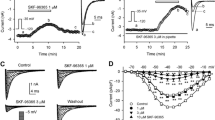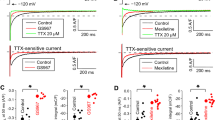Abstract
Tetrodotoxin (TTX) is believed to be the most selective inhibitor of voltage-gated fast Na+ channels in excitable tissues, including nerve, skeletal muscle, and heart, although TTX sensitivity of the latter is lower than the former by at least three orders of magnitude. In the present study, the TTX sensitivity of L-type Ca2+ current (I Ca) was studied in isolated canine ventricular cells using conventional voltage clamp and action potential voltage clamp techniques. TTX was found to block I Ca in a reversible manner without altering inactivation kinetics of I Ca. Fitting results to the Hill equation, an IC50 value of 55 ± 2 μM was obtained with a Hill coefficient of unity (1.0 ± s0.04). The current was fully abolished by 1 μM nisoldipine, indicating that it was really I Ca. Under action potential voltage clamp conditions, the TTX-sensitive current displayed the typical fingerprint of I Ca, which was absent in the presence of nisoldipine. Stick-and-ball models for Cav1.2 and Nav1.5 channel proteins were constructed to explain the differences observed between action of TTX on cardiac I Ca and I Na. This is the first report demonstrating TTX to interact with L-type calcium current in the heart.





Similar content being viewed by others
References
Aggarwal R, Shorofsky SR, Goldman L, Balke CW (1997) Tetrodotoxin-blockable calcium currents in rat ventricular myocytes; a third type of cardiac cell sodium current. J Physiol (Lond) 505:353–369
Alvarez JL, Salinas-Stefanon E, Orta G, Ferrer T, Talavera K, Galán L, Vassort G (2004) Occurrence of a tetrodotoxin-sensitive calcium current in rat ventricular myocytes after long-term myocardial infarction. Cardiovasc Res 63:653–661
Baer M, Best PM, Reuter H (1976) Voltage-dependent action of tetrodotoxin in mammalian cardiac muscle. Nature 263:344–345
Bányász T, Fülöp L, Magyar J, Szentandrássy N, Varró A, Nánási PP (2003) Endocardial versus epicardial differences in L-type calcium current in canine ventricular myocytes studied by action potential voltage clamp. Cardiovasc Res 58:66–75
Brown AM, Lee KS, Powell T (1981) Sodium current in single rat heart muscle cells. J Physiol (Lond) 318:479–500
Chorvatova A, Snowdon R, Hart G, Hussain M (2004) Effects of pressure overload-induced hypertrophy on TTX-sensitive inward currents in guinea pig left ventricle. Mol Cell Biochem 261:217–226
Cole WC, Chartier D, Martin M, Leblanc N (1997) Ca2+ permeation through Na+ channels in guinea pig ventricular myocytes. Am J Physiol 273:H128–H137
Doerr T, Denger R, Trautwein W (1989) Calcium currents in single SA nodal cells of the rabbit heart studied with action potential clamp. Pflugers Arch 413:599–603
Doerr T, Denger R, Doerr A, Trautwein W (1990) Ionic currents contributing to the action potential in single ventricular myocytes of the guinea pig studied with action potential clamp. Pflugers Arch 416:230–237
Hamill OP, Marty A, Neher E, Sakmann B, Sigworth FJ (1981) Improved patch-clamp techniques for high-resolution current recording from cells and cell-free membrane patches. Pflugers Arch 391:85–100
Hancox JC, Levi AJ, Witchel HJ (1998) Time course and voltage dependence of expressed HERG current compared with the native “rapid” delayed rectifier K current during the cardiac ventricular action potential. Pflugers Arch 436:843–853
Haverinen J, Hassinen M, Vornanen M (2007) Fish cardiac sodium channels are tetrodotoxin sensitive. Acta Physiol (Oxf) 191:197–204
Heinemann SH, Terlau H, Stühmer W, Imoto K, Numa S (1992) Calcium channel characteristics conferred on the sodium channel by single mutations. Nature 356:441–443
Heubach JF, Köhler A, Wettwer E, Ravens U (2000) T-type and tetrodotoxin-sensitive Ca2+ currents coexist in guinea pig ventricular myocytes and are both blocked by mibefradil. Circ Res 86:628–635
Hille B (2001) Ion channels in excitable membranes. Sinauer Associates Inc, Sunderland
Horváth B, Magyar J, Szentandrássy N, Birinyi P, Nánási PP, Bányász T (2006) Contribution of I Ks to ventricular repolarization in canine myocytes. Pflugers Arch 452:698–706
Lemaire S, Piot C, Seguin J, Nargeot J, Richard S (1995) Tetrodotoxin-sensitive Ca2+ and Ba2+ currents in human atrial cells. Receptors Channels 3:71–81
Linz KW, Meyer R (2000) Profile and kinetics of L-type calcium current during the cardiac ventricular action potential compared in guinea-pigs, rats and rabbits. Pflugers Arch 439:588–599
Nánási PP, Varró A, Lathrop DA, Bryant SH (1994) Effects of veratridine on Na and Ca currents in frog skeletal muscle. Gen Pharmacol 25:1661–1666
Pettersen EF, Goddard TD, Huang CC, Couch GS, Greenblatt DM, Meng EC, Ferrin TE (2004) UCSF Chimera—a visualization system for exploratory research and analysis. J Comput Chem 25:1605–1612
Tikhonov DB, Zhorov BS (2011) Possible roles of exceptionally conserved residues around the selectivity filters of sodium and calcium channels. J Biol Chem 286:2998–3006
Tikhonov DB, Zhorov BS (2005) Modeling P-loops domain of sodium channel: homology with potassium channels and interaction with ligands. Biophys J 88:184–197
Santana LF, Gómez AM, Lederer WJ (1998) Ca2+ flux through promiscuous cardiac Na+ channels: slip-mode conductance. Science 279:1027–1033
Su Z, Sheets M, Ishida H, Li F, Barry WH (2004) Saxitoxin blocks L-type I Ca. J Pharmacol Exp Ther 308:324–329
Sun H, Varela D, Chartier D, Ruben PC, Nattel S, Zamponi GW, Leblanc N (2008) Differential interactions of Na+ channel toxins with T-type Ca2+ channels. J Gen Physiol 132:101–113
Szabó G, Szentandrássy N, Bíró T, Tóth IB, Czifra G, Magyar J, Bányász T, Varró A, Kovács L, Nánási PP (2005) Asymmetrical distribution of ion channels in canine and human left ventricular wall: epicardium versus midmyocardium. Pflugers Arch 450:307–316
Szentandrássy N, Bányász T, Bíró T, Szabó G, Tóth IB, Magyar J, Lázár J, Varró A, Kovács L, Nánási PP (2005) Apico-basal inhomogeneity in distribution of ion channels in canine and human ventricular myocardium. Cardiovasc Res 65:851–860
Acknowledgments
Financial support for the studies was provided by grants from the Hungarian Research Fund (OTKA-K100151, OTKA-PD101171, OTKA-K101196, and CNK-77855). The authors thank Mrs. Vighné Katalin Horváth for excellent technical assistance.
Conflict of interest
The authors declare that that they have no conflict of interest.
Author Note
The experiments comply with the current laws of Hungary.
Author information
Authors and Affiliations
Corresponding author
Rights and permissions
About this article
Cite this article
Hegyi, B., Bárándi, L., Komáromi, I. et al. Tetrodotoxin blocks L-type Ca2+ channels in canine ventricular cardiomyocytes. Pflugers Arch - Eur J Physiol 464, 167–174 (2012). https://doi.org/10.1007/s00424-012-1114-y
Received:
Revised:
Accepted:
Published:
Issue Date:
DOI: https://doi.org/10.1007/s00424-012-1114-y




